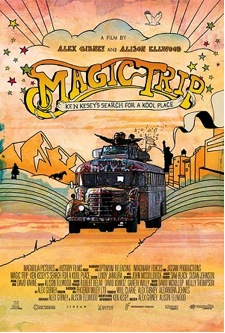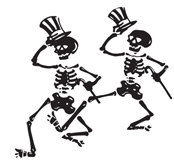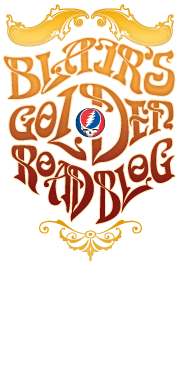In some ways, Tom Wolfe’s The Electric Kool-Aid Acid Test was my version of what Kerouac’s On the Road was for a lot of people 10 years older than I: a book that blew my mind wide open and pointed to all sorts of directions and possibilities. I first read it in the summer of 1970, following my junior year in high school, a few months after my first three Dead shows (at the Capitol Theater in Port Chester, NY, and the Fillmore East) on a family vacation to California, which included a drive down the coast from San Francisco to L.A. I have a vivid recollection of reading about the Acid Tests while we were passing Big Sur.
I was in that young-Dead Head phase of absorbing as much as I could about this band I had recently fallen in love with, and Wolfe’s book was the accepted revelatory touchstone dealing with the group’s early days. I had never taken a psychedelic, nor read Ken Kesey’s novels, but just about everything that went on in that book somehow resonated with me. I was looking for adventure wherever I could find it, and the Kesey/Prankster form of inner rebellion mixed with absurdist outer chaos appealed to me. And the saga of their famous bus trip in the summer of ’64 was irresistible. I used to doodle pictures of that psychedelic bus in my high school notebooks, in the same margins where I practiced illegible San Francisco poster lettering.
Through the years, I read other, more “objective,” accounts of the bus trip and the Acid Tests (most notably Paul Perry and Ken Babbs’ superb On the Bus), met and interviewed some of the people who had been part of that scene (including Kesey and Babbs), and finally viewed some of the voluminous film footage the Pranksters had shot during that era—what a sloppy but still inspiring mess that was!

Now we have Magic Trip: Ken Kesey’s Search for a Kool Place, a wonderful new documentary about the bus trip written and directed by Alex Gibney and Alison Ellwood. Gibney is one of the best in the business — an Oscar-winner for Taxi to the Dark Side in 2007, a nominee for Enron: The Smartest Guys in the Room (2005), who also directed Gonzo: The Life and Work of Dr. Hunter S. Thompson. Ellwood worked as an editor on several of Gibney’s films in recent years. Together, they’ve put together a breezy, colorful and amazingly coherent telling of the epic (and sometimes mundane) adventures of the Pranksters in their hey-day, using copious footage shot at the time and cleverly “narrated” by interview tapes of Kesey and others who were along for the ride (as well as actors voicing some of the individual Pranksters’ reflections). The Prankster film material is interspersed with lots of fun and illustrative archival news footage from the era, and Magic Trip is stuffed with great period music from beginning to end—everything from The Coasters to all sorts of very hip jazz to The Warlocks/Grateful Dead.
The film does a fantastic job of talking about how psychedelics infiltrated and influenced the culture. One of the most compelling sequences centers on an audio tape recording of parts of one of Kesey’s early acid trips at the Menlo Park Veteran’s Hospital (under government supervision). Without resorting to hoary psychedelic visual clichés, the filmmakers fancifully fill the screen with colors, forms and Kesey’s words as he speaks them; it’s very well done. The film also provides a pithy biography of Kesey and how he fits into the American creative landscape.
The footage of the bus trip forms the heart of Magic Trip, and the narrative recollections are honest and unflinching. This trip wasn’t all sunshine and roses, by any means. There were freak-outs and weird interpersonal stuff, and more than a few folks who were happy to get off the bus at different points along the way. But mostly, it is a fond depiction of a great adventure and social experiment. What happens when a bus of crazies, all loaded most of the time, encounters straight America? Actually, the bus and red-white-and-blue-clad Pranksters, mainly elicit smiles everywhere they go, from the rural South to the streets of Harlem. Most of the police who stop them on their journey just seem befuddled. After all, in mid-1964, LSD was virtually unknown, so the Pranksters’ odd behavior probably just seemed, well, odd.
The story has never been told so well in this linear way, and even though I have seen many hours of Prankster footage through the years, there was lots of stuff I’d never seen before. I particularly appreciated the segment dealing with the drive back from New York, which merits just a few pages in Wolfe’s book. (In fact, the whole bus trip takes up just an eighth or so of The Electric Kool-Aid Acid Test.) Though centered on Kesey, the film is not a hagiography, and the thoughts of many of the other Pranksters carry much of the storytelling. The depiction of Neal Cassady is considerably less romanticized than in some accounts, and I’m guessing perhaps more accurate.
There is a brief recapitulation of what happened to the Pranksters after the bus trip—the Acid Tests and Kesey’s move to Oregon—but this is not the film’s strength. It doesn’t even mention Kesey’s bust before the Trips Festival, nor his escape to Mexico, the Prankster reunion there, his subsequent secret return and all the madness that surrounded that epoch. Would it be greedy of me to implore Gibney and Eastwood to make Magic Trip Part 2: The Acid Tests? In any case, it really feels as if they got this one right. Between Magic Trip and the Wavy Gravy doc Saint Misbehavin’, this has been a great year for well-told tales from the ’60s. At last!
Magic Trip opens in select cities on August 5, but I managed to catch it “On Demand” on my Comcast cable the other night, so maybe it’s available where you are, too. It’s well worth your time. It’s certainly among the more evocative and unusual portraits of that era and the nascent counterculture I’ve seen. Don’t miss it!
Check an exclusive film clip featuring Jerry, Pigpen and the gang performing at the Acid Test here:






